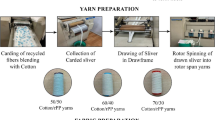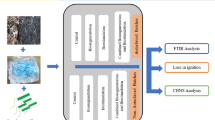Abstract
Management of disposable face mask (FM) used as personal protective equipment against transmission of COVID-19 has emerged as one of the key issues of COVID-19 pandemic. Disposable FM is a potential source of microplastic fibers in the environment. In this study, FM as carbon source for the cultivation of Pleurotus ostreatus mushroom was investigated in the attempt to reduce plastic build up in the environment due to its disposal. Growth substrate was prepared using FM as sole and/or partial carbon source varied with mahogany wood shavings (MWS) at 25, 50, 75, and 100% composition (wt/wt). Visual sorting under stereo microscope to detect presence or absence of microplastics in the mushrooms produced was conducted. Shortest spawn run (26 days) was recorded in MWS:FM 100:0 and optimum number of fruiting bodies (28) was achieved at MWS:FM 75:25; while, optimal fruiting body (fresh weight) (71 g), biological efficiency (88.8%), and proximate outputs (except carbohydrate) were achieved at MWS:FM of 25:75. The features of mushroom produced from MWS:FM 0:100 through visual sorting were suggestive of microplastics pollution. This study demonstrated the ability of P. ostreatus to utilize disposable FM as growth substrate for its production.






Similar content being viewed by others
Data availability
The data generated and analyzed during this study are available from the corresponding author on reasonable requests.
References
World Health Organization (2022) WHO coronavirus (COVID-19) dashboard. https://covid19.who.int/, Accessed 28 July 2023
Feng S, Shen C, Xia N, Song W, Fan M, Cowling BJ (2020) Rational use of face masks in the COVID-19 pandemic. Lancet Respir Med 8(5):434–436. https://doi.org/10.1016/S2213-2600(20)30134-X
Selvaranjan K, Navaratnam S, Rajeev P, Ravintherakumaran N (2021) Environmental challenges induced by extensive use of face masks during COVID-19: a review and potential solutions. Environ Chall 3:100039. https://doi.org/10.1016/j.envc.2021.100039
Prata JC, Silva ALP, Walker TR, Duarte AC, Rocha-Santos T (2020) COVID-19 pandemic repercussions on the use and management of plastics. Environ Sci Technol 54:7760–7765
Ivanovic T, Gräbsch C, Som C, Nowack B (2023) The effect of the Sars-Cov-2 pandemic on the use of personal protective equipment in hospitals. J Mater Cycles Waste Manage. https://doi.org/10.1007/s10163-023-01745-1
Plastics Europe (2019) Plastics – the Facts 2019. An analysis of European plastics production, demand, and waste data. http://www.plasticseurope.org/, Accessed 5 May 2022
Das O, Neisiany RE, Capezza AJ, Hedenqvist MS, Försth M, Xu Q, Jiang L, Ji D, Ramakrishna S (2020) The need for fully bio-based face masks to counter coronavirus outbreaks: a perspective. Sci Total Environ 736:139611. https://doi.org/10.1016/j.scitotenv.2020.139611
Jung S, Lee S, Dou X, Kwon EE (2021) Valorization of disposable COVID-19 mask through the thermo-chemical process. Chem Eng J 405:126658. https://doi.org/10.1016/j.cej.2020.126658
Aragaw TA, Mekonnen BA (2021) Current plastics pollution threats due to COVID-19 and its possible mitigation techniques: a waste-to-energy conversion via pyrolysis. Environ Syst Res 10:8. https://doi.org/10.1186/s40068-020-00217-x
Saberian M, Li J, Kilmartin-Lynch S, Boroujeni M (2021) Repurposing of COVID-19 single use face masks for pavements base/subbase. Sci Total Environ 769:145527. https://doi.org/10.1016/j.scitotenv.2021.145527
Kilmartin-Lynch S, Saberian M, Li J, Roychand R, Zhang G (2021) Preliminary evaluation of the feasibility of using polypropylene fibres from COVID-19 single-use face masks to improve the mechanical properties of concrete. J Clean Prod 296:126460. https://doi.org/10.1016/j.jclepro.2021.126460
Hu X, Lin Z (2021) Transforming waste polypropylene face masks into S-doped porous carbon as the cathode electrode for supercapacitors. Ionics. https://doi.org/10.1007/s11581-021-03949-7
Zeghal E, Vaksmaa A, Vielfaure H, Boekhout T, Niemann H (2021) The potential role of marine fungi in plastic degradation – A review. Front Mar Sci. https://doi.org/10.3389/fmars.2021.738877
Milstein O, Gersonde R, Huttermann A, Chen MJ, Meister JJ (1992) Fungal biodegradation of lignopolystyrene graft copolymers. Appl Environ Microbiol 58(10):3225–3232. https://doi.org/10.1128/aem.58.103225-3232.1992
Guess AC, Miller PD, Volk TJ (2006) White-rot fungi demonstrate first biodegradation of phenolic resin. Environ Sci Technol 40(13):4196–4199. https://doi.org/10.1021/es060408h
Ahmad Zakil F, Xuan LH, Zaman N, Alan NI, Aida Salahutheen NA, Mohd Sueb NS, Isha R (2022) Growth performance and mineral analysis of Pleurotus ostreatus from various agricultural wastes mixed with rubber tree sawdust in Malaysia. Bioresour Technol Rep 17:e100873. https://doi.org/10.1016/j.biteb.2021.100873
Kavipriya R, Revathy N, Karthikeyan CV (2020) Comparative studies using various substrates for enhancing yield of Pleurotus spp. Int J Curr Microbiol Appl Sci 9(11):2831–2852
Tesfaw A, Tadesse A, Kiros G (2015) Optimization of oyster (Pleurotus ostreatus) mushroom cultivation using locally available substrates and materials in Debre. Ethiopia J Appl Biol and Biotechnol 3(01):15–20
Bellettini MB, Fiorda FA, Maieves HA, Teixeira GL, Avila S, Hornung PS, Júnior AM, Ribani RH (2019) Factors affecting mushroom Pleurotus spp. Saudi J Biol Sci 26(4):633–646
Ali SS, Al-Tohamy R, Koutra E, El-Naggar AH, Kornaros M, Sun J (2020) Valorizing lignin-like dyes and textile dyeing wastewater by a newly constructed lipid-producing and lignin-modifying oleaginous yeast consortium valued for biodiesel and bioremediation. J Hazard Mater 403:e123575
Chai WY, Krishnan UG, Sabaratnam V, Lee Tan JB (2021) Assessment of coffee waste in formulation of substrate for oyster mushrooms Pleurotus pulmonarius and Pleurotus floridanus. Future Foods 4:e100075
Jen Z, Li Y, Ren J, Qin N (2018) Yield, nutritional content, and antioxidant activity of Pleurotus ostreatus on corncobs supplemented with herb residues. Mycobiology 46(1):24–32. https://doi.org/10.1080/12298093.2018.1454014
Adenipekun CO, Omolaso PO (2015) Comparative study on cultivation, yield performance and proximate composition of Pleurotus pulmonarius Fries (Quelet) on rice straw and banana leaves. World J of Agric Sci 11(3):151–158
Mattila P, Salo-Vaananen P, Konko K, Aro H, Jalava T (2002) Basic composition and amino acid contents of mushrooms cultivated in Finland. J Agric Food Chem 50:6419–6422
Association of Official Analytical Chemists (AOAC) (2005) Official Methods of Analysis, 8th edn. Arlington VA, USA
Mariano S, Tacconi S, Fidaleo M, Rossi M, Dini L (2021) Micro and nanoplastics identification: Classic methods and innovative detection techniques. Front Toxicol 3:636640. https://doi.org/10.3389/ftox.2021.636640
Keene J, Turner A (2023) Microplastics in coastal urban sediments: Discrepancies in concentration and character revealed by different approaches to sample processing. Sci o Total Environ 865:161140. https://doi.org/10.1016/j.scitotenv.2022.161140
Girmay Z, Gorems W, Birhanu G, Zewdie S (2016) Growth and yield performance of Pleurotus ostreatus (Jacq. Fr.) Kumm (oyster mushroom) on different substrates. AMB Expr 6:87. https://doi.org/10.1186/s13568-016-0265-1
Echem P, Chukunda F (2018) Nutrient composition of mushroom: Pleurotus ostreatus (Jacaum, ex. Fr. Kummer) grown on different agricultural wastes. Agric Food Sci Res 5(1):1–5
Chang ST, Miles PG (2004) Mushrooms: cultivation, nutritional value, medicinal effect and environmental impact, 2nd edn. CRC Press, Boca Raton
Yang W, Guo F, Wan Z (2013) Yield and size of oyster mushroom grown on rice/wheat straw basal substrate supplemented with cotton seed hull. Saudi J Biol Sci 20:333–338
Patel H, Gupte A, Gupte S (2009) Effect of different culture conditions and inducers on production of laccase by a basidiomycete fungal isolate Pleurotus ostreatus HP-1 under solid-state fermentation. BioResources 4:268–284
Luz JM, Nunes MD, Paes SA, Torres DP, Silva CSM, Kasuya MC (2012) Lignocellulolytic enzyme production of Pleurotus ostreatus growth in agroindustrial wastes. Braz J Microbiol 43:1508–1515
El-Batal AI, ElKenawy NM, Yassin AS, Amin MA (2015) Laccase production by Pleurotus ostreatus and its application in synthesis of gold nanoparticles. Biotechnol Rep 5:31–39
Bettin F, Montanari Q, Calloni R, Gaio TA, Silveira MM, Dillon AJP (2009) Production of laccases in submerged process by Pleurotus sajor-caju PS-2001 in relation to carbon and organic nitrogen sources, antifoams and Tween 80. J Ind Microbiol Biotechnol 36(1):1–9. https://doi.org/10.1007/s10295-008-0463-1
Bhuyan MHMBU (2008) Study on preparation of low-cost spawn packets for the production of oyster mushroom (Pleurotus ostreatus) and its proximate analysis. M.S.Thesis, Sher-e-Bangla Agriculture University, Dhaka, Bangladesh
Owaid MN, Abed AM, Nassar BM (2015) Recycling cardboard wastes to produce blue oyster mushroom Pleurotus ostreatus in Iraq. Emir J Food Agric 27:537–541
Muswati C, Simango K, Tapfumaneyi L, Mutetwa M, Ngezimana W (2021) The effects of different substrate combinations on growth and yield of oyster mushroom (Pleurotus ostreatus). Int J Agron 9962285:1–10. https://doi.org/10.1155/2021/9962285
Ali MR, Hoque MS, Ahmed KU, Rahman MH (2010) Effect of wheat bran supplements with sugarcane bagasse on the yield and proximate composition of oyster mushroom (Pleurotus ostreatus). Bangladesh J Mushrooms 4(2):21–26
Nuruddin MM, Rahman MH, Ahmed KU, Hossain A, Sultana N (2010) Effect of cow dung supplements with rice straw on the yield and proximate composition of oyster mushroom (Pleurotus ostreatus). Bangladesh J Mushrooms 4(2):45–52
Obodai M, Ferreira I, Fernandes A, Barros L, Mensah ND, Dzomeku M, Urben A, Prempeh J, Takli R (2014) Evaluation of the chemical and antioxidant properties of wild and cultivated mushrooms of Ghana. Molecules (Basel, Switzerland) 19:19532–19548
Acknowledgements
The authors would like to thank the Management of Renewable Resource Centre, University of Ibadan, Ibadan, Nigeria and Dominic University, Ibadan, for access to their facilities.
Funding
This research did not receive any specific grant from funding agencies in the public, commercial, or not-for-profit sectors.
Author information
Authors and Affiliations
Contributions
All authors contributed to the study conception and design. Material preparation, data collection and analysis were performed by GBO. The first draft of the manuscript was written by GBO and LSA. All authors approved the final manuscript.
Corresponding author
Ethics declarations
Conflict of interest
The authors declare that they have no known competing financial interests or personal relationships that could have appeared to influence the work reported in this paper.
Additional information
Publisher's Note
Springer Nature remains neutral with regard to jurisdictional claims in published maps and institutional affiliations.
Rights and permissions
Springer Nature or its licensor (e.g. a society or other partner) holds exclusive rights to this article under a publishing agreement with the author(s) or other rightsholder(s); author self-archiving of the accepted manuscript version of this article is solely governed by the terms of such publishing agreement and applicable law.
About this article
Cite this article
Olakanmi, G.B., Lateef, S.A. & Ogunjobi, A.A. Utilization of disposable face masks for cultivation of Pleurotus ostreatus mushroom as a strategy for reducing environmental plastic pollution. J Mater Cycles Waste Manag 26, 578–590 (2024). https://doi.org/10.1007/s10163-023-01859-6
Received:
Accepted:
Published:
Issue Date:
DOI: https://doi.org/10.1007/s10163-023-01859-6




